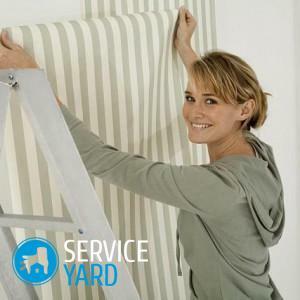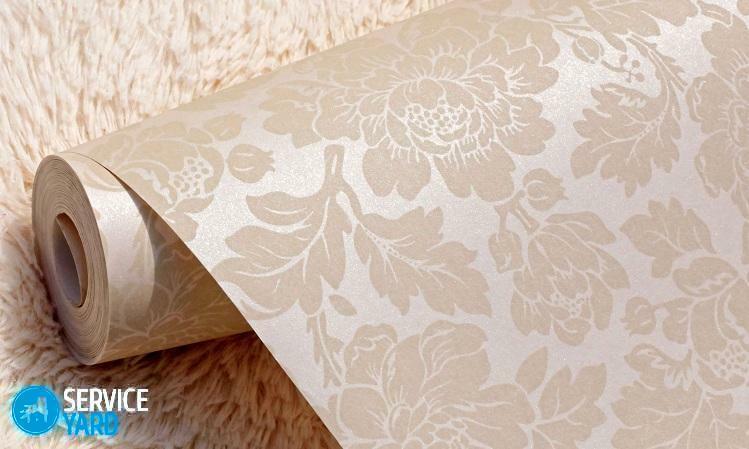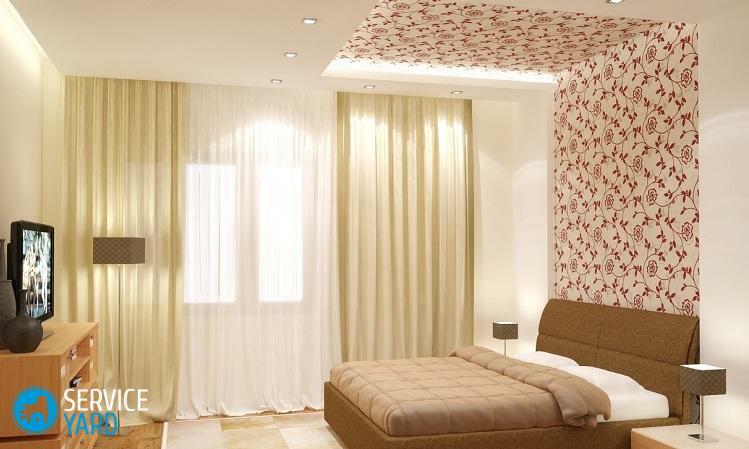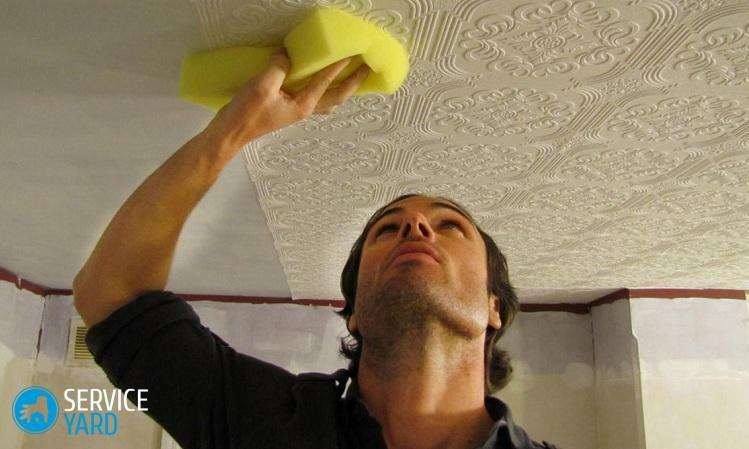
- What to glue?
- Paper
- Vinyl
- Fleece
- Features of working with different materials
- What do you need?
- Kleim wallpaper on the ceiling
To the fact that the walls are covered with wallpaper, all long accustomed to. But paper or nonwoven on the ceiling - a phenomenon so far relatively new. But many designers have already managed to evaluate the advantages of this kind of finishing and offer those who started repairs, a lot of interesting solutions. If you want and some of the skills you can and decorate the top of your apartment effectively and unusually. How to glue wallpaper on the ceiling? This modern form of finishing works will be discussed in our article.
to the contents ↑How to glue?
Before you glue the ceiling wallpaper, carefully read the assortment of building stores. The fact is that for the decoration of the ceiling not all materials are suitable. For example:
- from textile is better to refuse right away - the fabric is too heavy, and the weight in this story plays a very big role;
- , the same can be said for most types of wooden plating - it will be suitable for it, only it is necessary to fasten it not on glue, but on something else.
You need to choose such wallpaper to 1 square.m weighed not more than 110 g, but the density must be high enough. They can be:
- paper;
- is vinyl;
- non-woven.
Important! Glass mosaic and liquid are also good, but neither are wallpaper at all, so the finishing technology will be completely different from the one used for surface painting with vinyl or non-woven fabric.
to Contents ↑Paper
Advantages of this material are well known:
- lets air through, allowing the surface to "breathe";
- is environmentally friendly;
- is easy to process;
- is cheap.
An important moment for the designer is a large assortment of this kind of products from suppliers. Paper wallpaper is different in color and texture, so there is always the opportunity to choose something interesting, while quite budgetary.
There are drawbacks in such wallpapers, and very significant:
- badly refer to moisture;
- fade;
- do not last long.
If fast abrasion during the design of the ceiling does not play a big role, then the fact that the wallpaper fade can be extremely unpleasant.
Important! If you have stopped on paper wallpaper, choose one that is designed for painting - you can paint them many times.

What are paper wallpapers?
The answer to the question whether it is possible to glue wallpaper on the ceiling is unambiguous - of course, you can, but you have to choose the right grade, even if it's paper. Wallpaper for painting, which most often for a similar purpose and are applied, are of two types:
- structural;
- is coarse-grained.
Structural
They are glued from several layers of paper with embossing. As a rule, white sheets are used in production. This type of wallpaper is produced in wide rolls, which also have a long length, so that for the pasting of ceilings they are very suitable. The surface is flat, almost without joints. There are two types of structural wallpaper:
- two-layer;
- three-layer.
The first will cost less, but the second will be longer to serve, and glue them, oddly enough, easier.
Important! When gluing structural wallpaper, the adhesive is not applied to paper, but to the ceiling.
Coarse-grained
This kind of coating consists of two paper layers. Between them is laid a layer of sawdust, very well pressed. Such wallpaper is made of very thick paper. There is no drawing, so it is not necessary to adjust anything, but the surface has a beautiful granular texture. But for a ceiling this material can appear too heavy.
to the contents ↑Vinyl
Puzzled by the problem of how to properly glue the wallpaper on the ceiling, pay attention to material such as vinyl. The assortment of vinyl wallpaper is smaller than paper, they are more expensive, but this coating has a lot of other advantages, the main of which are:
- resistance to moisture;
- strength:
- decorativeness.
Important! Unfortunately, not all varieties of vinyl wallpaper are suitable for gluing the ceiling. This material has quite a lot of weight, so you should choose very carefully.
They look more effective than paper ones and serve about twice as long. But vinyl wallpaper, too, are different. On sale you can meet:
- foamed vinyl;
- tight vinyl;
- silkscreen printing.
Foamed vinyl
The wallpaper of foamed vinyl is quite easy to distinguish. They have a pronounced relief and an effective texture. You can glue these even in the bathroom and in the kitchen - they are sufficiently resistant to moisture, and to steam. They are easy to take care of - any household cleaning products are suitable.
They have a drawback, however, also - this material does not allow air to pass, so it is not suitable for finishing:
- for children;
- bedrooms;
- living room.
But nothing prevents to paste such, for example, in the hallway or in the toilet.
Important! If the room is poorly ventilated, you can not trim it with foamed vinyl.

Thick vinyl
This magnificent material, made with the use of special heat treatment, absolutely does not react with the environment, does not absorb water, nor smell.
Two-layer paper or specially prepared fabric with a high content of natural fiber is used for the substrate. Serves dense vinyl remarkably long. It is completely insensitive to sunlight, resistant to mechanical influences, and it can be washed with anything, up to an iron brush.
There are several other very important advantages:
- material does not change its dimensions when pasted;
- vinyl does not shrink when dry;
- does not shine, respectively - well hides small flaws in the surface.
Silk screen
This kind of vinyl also consists of two layers. The top layer is decorative, it is very similar to natural silk. On sale you can find both smooth varieties of this material, and relief.
Its advantages are the same as those of other vinyl wallpapers:
- does not burn out;
- has little abrasion;
- does not spoil under the influence of water;
- does not change the size when wet;
- is easy to glue.
Important! Vinyl wallpaper can also be designed for painting.
to the contents ↑Flizelin
If you are first thinking how to glue wallpaper on the ceiling, the fleece for it fits more than other materials. Advantages of non-woven wallpaper:
- light weight;
- strength;
- resistance to mechanical damage;
- property to keep shape and size when wet;
- decorativeness;
- is environmentally friendly - they perfectly pass air and do not emit harmful substances.
How to glue non-woven wallpaper on the ceiling? This can be done without an assistant. The ceiling is covered with glue, after which it is superimposed with light cloths made of this material.
Important! Perhaps their only significant drawback is transparency. Therefore, if there are spots or cracks on the ceiling that you can not get rid of, you must apply a good primer or glue a layer of light paper. The main difference from paper and vinyl wallpaper - a non-woven base of synthetic fibers and cellulose.
to the contents ↑Features of work with different materials
Before you glue wallpaper on the ceiling with your own hands, consider some specific qualities of different types of materials:
- Vinyl strips should be placed in the same way as they were on the roll.
- For each material has its own glue, so do not forget to look at the markings.
- Flizelin before gluing is not necessary.
- When working with paper and vinyl, glue is applied to both the ceiling and wallpaper, and when pasting with nonwoven fabric, only on the ceiling.
What do you need?
Pasting the ceiling with your own hands - the process is not so difficult, if you need to properly prepare for it. First, take care of the tools. You need:
- stepladder;
- tableware for glue;
- brush or roller for glue;
- measuring tape;
- soft rags;
- sharp knife;
- scissors;
- pencil or marker;
- plastic roller or spatula( smooth surface).
In principle, instead of a ladder, you can use the table, if you can easily get it to the ceiling. But the ladder is more convenient to move.
to content ↑Glue wallpaper to ceiling
The gluing process consists of several stages:
- surface preparation;
- wallpaper preparation;
- preparation of materials;
- actually gluing;
- smoothing.
Cooking ceiling
Adhesive wallpaper is best during the day, under natural light. And it's not so much that in daylight, defects in work are better visible. It's just necessary to comply with safety techniques, that is, first of all - to disconnect electricity in the apartment.
Next:
- Bring out furniture that can be removed from the room.
- Cover the remaining items and floors with plastic wrap.
- Remove the old coating from the ceiling - you can leave only oil paint or water-based paint.
- Seal all joints on the ceiling, if any.
- Wait until the mortar dries.
- Grind the sealed joints with a sandpaper.
- If the windows face the sunny side, close the curtains.
- Prime the surface.
- Dry the ceiling and apply another layer of soil.
- Allow the layer to dry, once again coat the ceiling with primer.
- After complete drying, mark the first line under the wallpaper.
Primer
Primer enhances the adhesion of wallpaper to the surface. Its appearance depends on the surface. For example:
- If there is paint left on the ceiling, the primer on the acrylic base will work.
- If you managed to clean the surface completely, you can primed it with wallpaper glue.
How to partition?
When marking, there is always a question of how to glue panels - parallel to windows or perpendicularly. The second option is preferable, since joints will not be so noticeable. But if you live in a corner room with two windows on adjacent walls - you can glue anything.
Very good, if you have a laser level. Then you will put the first line of the markup without any problems. But there is also a traditional option - a lace and a pencil:
- Measure the width of the roll.
- Take 2-3 cm from the result.
- From one of the angles, measure the distance obtained.
- Do the same on the opposite wall.
- Between the labels, pull the string, fixing it in any convenient way( for example, scotch tape).
- Apply a few marks on the shoelace.

Preparing the adhesive
The strength of the joints of the surfaces depends largely on the glue, so it is necessary to treat extremely carefully the process of its preparation. How to breed it is indicated in the instructions, and it must be fully implemented.
Usually the procedure looks like this:
- Pour as much water into the container intended for the glue as specified in the instruction.
- Add a little dry mixture, mix well.
- Add the mixture, continuously mixing - this will give a homogeneous mass without lumps.
- Leave the glue on for 20-30 minutes to allow it to swell.
Important! Of the good adhesives you can note the products of the following brands: "Cleo", "Quelyd", "Methylan", "Moment", "Pufas".Carefully read on the packaging, for what type of coating is intended for this or that kind of mixture.
Cutting the wallpaper
Vinyl and paper wallpaper is cut before gluing. It is important to correctly determine the length of the panel. Measure the length of the room, add to it 10-12 cm on the allowances - the wallpaper should go to the walls.
If the material is thick, then glue it without allowances, strictly at the joints.
Important! Strips on the entire ceiling should be prepared at once. Wide wallpaper cut with a margin - the excess can be cut off later.
Gluing
The gluing technology differs little from that used in wall finishing:
- Apply glue to the ceiling - do it better with a roller so that the layer is even and without lacunae.
- If necessary, apply glue to the wallpaper.
- Place a strip on the ceiling with marks, press firmly.
- With a plastic roller or spatula, smooth out the cloth.
- With a soft cloth, remove excess glue.
- The edges should be neatly applied with a brush.
- Glue the next sheet.
Important! If you do not have an assistant, you need to work very quickly so that the glue does not dry.
Some subtleties of
There are two points to which you should pay special attention:
- gluing the place where the lamp will be;
- pasting of corners.
Where there is a lamp, make a few short cuts, and then gently bend the wallpaper inside or cut. As for the corners, the sequence will be as follows:
- Move the panel into the corner.
- Mark the allowance for the angle location.
- Remove the strip and make incisions - you should get a cut out box.
- Glue the panel, joining the cuts on the allowances.
Now you are convinced that gluing the wallpaper on the ceiling is not as bad as it seemed initially. Therefore, you can fully cope on your own, respectively - the result will also please you much more, because in the process of decorating your home, you literally invest a part of your soul.

